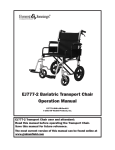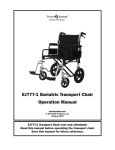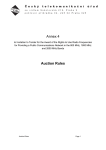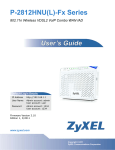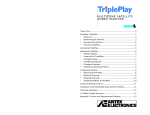Download Appendix 4 Auction Rules
Transcript
Appendix 4 to the Invitation to tender for the award of the rights to use radio frequencies for providing a public communications network in the 800 MHz, 1800 MHz and 2600 MHz bands Auction Rules Contents 1 INTRODUCTION ............................................................................................................................. 2 2 AUCTION ........................................................................................................................................ 2 2.1 2.2 2.3 GENERAL INFORMATION ............................................................................................................. 2 AUCTION FORMAT ...................................................................................................................... 2 AUCTION SCHEME ...................................................................................................................... 3 3 SUBJECT MATTER OF THE AUCTION ........................................................................................ 4 4 AUCTION PHASE ........................................................................................................................... 4 4.1 ELECTRONIC AUCTION SYSTEM (EAS) ........................................................................................ 4 4.2 FORCE MAJEURE ........................................................................................................................ 6 4.3 THE COURSE OF THE AUCTION PHASE ........................................................................................ 7 4.3.1 Bid Submission by Auction Participants .............................................................................. 7 4.3.2 The First Auction Round ...................................................................................................... 8 4.3.3 Subsequent Auction Rounds ............................................................................................... 9 4.3.4 The Final Auction Round ..................................................................................................... 9 4.4 THE RULES OF THE AUCTION AND THE POSSIBILITIES AVAILABLE TO AUCTION PARTICIPANTS ...... 10 4.4.1 Rules of Conduct ............................................................................................................... 10 4.4.2 Activity Rules ..................................................................................................................... 10 4.4.3 Highest Bid Holder ............................................................................................................. 12 4.4.4 The Minimum Bid Range ................................................................................................... 12 4.4.5 Abstention and Time Out ................................................................................................... 13 4.4.6 Highest Bid Withdrawal ..................................................................................................... 13 4.4.7 Rules for Submitting Bids for Auction Lot A3 .................................................................... 14 4.4.8 Identification of Auction Winners and the Termination of the Auction Phase.................... 14 4.5 INFORMATION TO BE PROVIDED BY THE EAS DURING THE AUCTION PHASE ................................. 15 5 DISTRIBUTION OF FREQUENCIES ............................................................................................ 17 6 EXCLUSION OF AN APPLICANT DURING THE AUCTION ....................................................... 19 7 CLOSING THE AUCTION ............................................................................................................. 19 Auction Rules Page 1 1 INTRODUCTION These Auction Rules are an Annex to the Invitation to Tender. It specifies the details of the rules of the Auction set out in Chapter 7 of the ITT. 2 AUCTION 2.1 General Information The auction is divided into 2 phases, including the Auction Phase and Frequency Distribution phase. The auction can only be attended by Applicants who have fulfilled the qualification requirements indicated in Chapter 6 of the ITT. 2.2 Auction Format The Auction format to be used in the Auction Phase is a simultaneous multiple round Auction (SMRA), organised as an ascending open Auction. The Auction Participant can change his auction strategy during the Auction Phase. In the preceding paragraph, the following auction principles should be understood as follows: simultaneous Auction – all the Auction Lots are offered simultaneously in the Auction Phase; multiple-round Auction – the Auction Phase is organised as a system of successive Action Rounds, in which the Auction Participants place their Bids for selected Auction Lots. The Auction Phase ends in a final Auction round according to the conditions set up in the Auction Rules; ascending Auction – the Auction Participants increase the Bid price of the Auction Lot during the Auction Phase, compared to the previous Highest Bid; open Auction – information about Auction Lot occupancy and the Highest Bid in respect of all Auction Lots is available to All Auction Participants after evaluation of each Auction Round, but the identity of the Auction Participant remains undisclosed throughout the Auction Phase; auction strategy change – the Auction Participant can change the structure or extent of his Bid, including the possibility to withdraw the Highest Bid under the conditions set up in the Auction Rules. Auction Rules Page 2 2.3 Auction Scheme Auction Rules Page 3 3 SUBJECT MATTER OF THE AUCTION Auction Lot Frequency range Category Frequencies [MHz] Auction Lots 791-796 / 832-837 1 real (= concrete) lot 2×5 MHz 796-811 / 837-852 3 abstract lots 2×5 MHz A3 811-821 / 852-862 1 real lot 2×10 MHz B1 1842.3-1857.9/ 1747.3-1762.9 & 1805.1-1805.3/ 1710.1-1710.3 1 real lot 2×15,8 MHz 1805-1880 / 1710-1785 (unallocated part) 9 abstract lots 2×1 MHz A1 A2 800 MHz paired spectrum 1800 MHz paired spectrum B2 Spectral limit 2×10 MHz Minimum Bid range Not determined 2×23 MHz in aggregate with the radio frequencies held in the 1800 MHz band Not determined Minimum price [CZK million/Lot] Activity points [points/Lot] 1,010 10 1,110 10 2,220 20 500 5 30 1 C 2600 MHz paired spectrum 2620-2670 / 2500-2570 14 abstract lots 2×5 MHz 2×20 MHz 2×10 MHz 80 1 D 2600 MHz unpaired spectrum 2570-2620 9 abstract lots 5 MHz Not determined 15 MHz 30 0.5 4 AUCTION PHASE 4.1 Electronic Auction System (EAS) Proper course of the Auction Phase will be provided by the Electronic Auction System (EAS), operated by the Office for this purpose. The EAS is operated on the EAS provider’s secured servers and will be accessible via the Internet with a high level of access security. The EAS will enable Auction Participants to submit only Bids that comply with the ITT and the Auction Rules. In addition to the possibility to put in Bids in the individual Auction Rounds, the EAS interface will provide Auction Participants with information about the course of the Auction Phase to the extent defined in Chapter 4.5 of the Auction Rules. Only those Auction Participants can log on the EAS who have received access data and a digital certificate from the Office. The Office will provide these access data only to the Applicants who have duly qualified in accordance with the provisions of Chapter 6 of the ITT and have received an Auction participation certificate. The digital certificate must be installed on the computer from which the Auction Participant connects to the EAS. The Auction Participant is responsible for the security (protection against abuse) of his logon data and the allocated password. For security reasons, the EAS will only be accessible from the territory of the Czech Republic. Before the commencement of the Auction Phase, all Auction Participants must notify 10 IP addresses, from which they will be able to access the EAS. The EAS will not be accessible from any other IP addresses. The Participant must, without unnecessary delay, inform the Office about any case of breach of the protection of the access data or the password. An Auction Participant can log on the EAS from only one computer at a time. In the event of any unforeseen technical problems or internet connection outage, the Auction Participant will Auction Rules Page 4 be automatically disconnected from the EAS and the Auction Participant will then be able to log on from another computer containing the necessary certificate. In such cases, the Office may suspend the Auction Round on the Auction Participant’s request. Cases of unforeseen technical problems are specified in more detail in Chapter 4.2 of the Auction Rules. No data are saved on the Auction Participant’s computer during the Auction Round: all changes are recorded directly in the EAS. The Office bears no liability for any technical problems or internet connection problems on the Auction Participant’s side that hinder the Auction Participant from connecting to the Electronic Auction System. The Auction Participants’ internet connection should be wellsecured and fast enough (download speed of at least 128kbit/s) and there should be a standby computer to be used if there is any technical problem. The Office recommends to ensure that the computers via which the Auction Participant accesses the EAS are not used for any other purpose during the Auction and that no other software, which is not necessary for access to the EAS, is simultaneously used on such computers. All Auction Participants will act as absolutely anonymous parties in the EAS. All communication during the Auction phase will also be absolutely anonymous. For these purposes, the Auction Participants will be informed about their communication cover names and passwords for use during the Auction phase. Their identity will be disclosed only after the end of the Final auction round as defined in Chapter 4.3.4 of the Auction rules. Security of the EAS operator’s facilities against attack and against disclosure of the Auction Participants’ identity will be provided by adequate HW and SW means on the side of the EAS, by secured connection between the Auction Participant’s web browser and the EAS system server (protected by a coded network protocol) and by a system-controlled mandatory minimum level of logon data security. The EAS and its individual processes will be preset so as to be able, to the maximum possible extent, to eliminate any risk of inadvertent error (e.g. double click) on the Auction Participants’ side. User interface will be available to the Auction Participants within the EAS. It will provide the Auction Participants with all blank forms necessary for the submission of the Bids, as well as the range of information about the course of the Auction as defined in Chapter 4.5 of the Auction Rules, and access to the Office’s other notices for the Auction Participants during the Auction. The interface also includes a clock synchronized with the Auction server to indicate the time information such as the time remaining to the end of the limit of the Auction Round, the exact time when the Auction Participant put in his Bid etc. All the rules (contained in the Auction Rules) necessary for carrying out the Auction Phase – including but not limited to, the rules for putting in the Bids, for compliance with the Spectral Limits, for the Minimum Bid Range, for calculating the Activity points used in the Auction Round and the available Eligibility points, for identifying the Highest Bid Holder, for the determination of the final Auction Round etc. – are implemented in the EAS and are automatically applied and/or checked during the course of the Auction phase. To determine the Highest Bid Holder in the case of simultaneous submission of two or more Bids, a deterministic algorithm will be used, implemented into the EAS; on the basis of the data provided by the Office and by the Auction Participants, and with the use of other deterministic data (e.g. the serial number of the round etc.), this deterministic algorithm will create one (or Auction Rules Page 5 more, if necessary) pseudo-random 128-bit binary number for each Auction Round. The procedure based on Chapter 4.4.3 of the Auction Rules will ensure that the determination of the Highest Bid Holder cannot be directly influenced by the Auction Participants and that the determination of the Highest Bod Holder can be checked retrospectively. Before commencement of the Auction Phase, each of the Auction Participants will have the opportunity to enter one piece of input data for subsequent calculation of pseudo-random numbers. This process is fully implemented in the EAS. The Office will notify the format of the input data to the Auction Participants during the training. The EAS contains a one-way message sending system, which will be used by the Office to send messages to Auction Participants during entire course of the Auction Phase. The Office expects this way of communication between itself and the Auction Participants to be the primary communication channel during the Auction Phase. The messages will be considered as delivered to the Auction Participant, once they are made public in the EAS user interface. During the course of the Auction and half an hour before the Auction, a telephone number will be available to the Auction Participants to call if they need to contact the Office. EAS technical support will also be provided at this telephone number. During the EAS training and the test Auction, the Auction Participants will be able to familiarise with the EAS environment, EAS functions and the processes associated with the implementation of the Auction Phase, including the anonymisation process and the problemreporting and incident-reporting process during the Auction Phase. An EAS user manual will also be available to the Participants. It will be handed over to them during the training. It contains the information to be learned by the Auction Participants before the commencement of the Auction Phase, including, in particular, the requirements for HW and SW facilities, logon instructions and a description of the interface and of the use of the EAS. The system requirements and the list of the supported and recommended operating systems and the required software necessary for access to the EAS (including, but not limited to, the web browser, JAVA application versions etc.) will be specified in the EAS user manual. The EAS as a whole, as well as its parts, subsystems and databases, including the graphics of the internet application and structure, are covered by copyright protection. All the ownership rights related to them are exercised by the EAS provider. In connection with the use of the EAS, the Auction Participants are not allowed to use any software, scripts or other similar mechanisms and actions that can affect the functions of the EAS or cause any other adverse impact on the operation of the EAS and which could overload the servers and the EAS infrastructure. 4.2 Force majeure If the Auction Phase has to be checked for compliance with the ITT conditions or any other important circumstances need to be verified, and in the case of unpredictable events that may affect significantly the course of the Auction Phase, the Office may interrupt, suspend or stop an Auction Round or the entire Auction Phase. Once an Auction Round is interrupted, the Office may: Auction Rules resume the Auction Round at the point where it was suspended, complete the Bid submission time limit period, close and evaluate the Auction Round and continue the Auction Phase; or Page 6 declare the Auction Round invalid and repeat such an Auction Round that has not yet been evaluated; or Once the Auction Phase is suspended, the Office may: resume the Auction Phase and continue by carrying the next Auction Round subsequent to the last completed Auction Round after which the Auction Phase was suspended; or declare the last still uncompleted Auction Round invalid, repeat such a still unevaluated Auction Round and continue the resumed Auction Phase; or declare the entire Auction Phase invalid and start the Auction Phase anew from its beginning. Examples of the unpredictable events to be addressed as described above include, without being limited to, technical problems on the side of the EAS provider, which may have an adverse impact on the Office or the Auction Participants, exclusion of an Applicant from further participation in the Tender under Section 21(6) of the Act, or serious and wide internet access connection failures. Information about the Office’s actions under these provisions will be provided to the Auction Participants through the EAS and, in the case of suspension of the Auction Phase, also by informing the Auction Participants’ contact persons indicated in the Application. 4.3 The Course of the Auction Phase 4.3.1 Bid Submission by Auction Participants Auction rounds take place on working days between 9.00 and 17.00 hours according to the firmly set Auction Day schedule. The Auction Day Schedule indicates the Bid Submission times for each Auction Participant. Upon expiry of this time, the Auction Round is terminated by evaluating all Bids and determining the Highest Bid Holders in the given Auction Round. There is a time limit on the time for the submission of Bids in each Auction Round. Unless otherwise provided by the Office, the Auction Rounds will start at the following fixed times: 9:00, 9:45, 10:30, 11:15, 14:00, 14:45, 15:30, and 16:15. The time available for Bid Submission in each Auction Round will be 20 minutes and the length of the break before the commencement of the next round will be 25 minutes. On the first two days of the Auction Phase the auction day schedule will be limited to four Auction Rounds a day and these four Auction Rounds will start at 9:00, 10:30, 14:00 and 15:30. The lengths of the Auction Rounds, the length of the break before the next Auction Round and the Auction Round start times may vary upon the Office’s decision during the Auction. The Auction Participants will be informed about any change in the schedule via the EAS. The time for the submission of Bids in an Auction Round will be reduced if all Auction Participants have made a Bid in the Auction Round or actively used the possibility of abstention. Premature termination of an Auction Round will be notified to all Auction Participants via the EAS. Auction Participants, who connect to the EAS during an Auction Round before the expiry of the time for the submission of Bids, will receive a blank form for the submission of Bids. The range of information contained in the Bid submission form is defined in Chapter 4.5 of the Auction Rules. Auction Rules Page 7 .Bids are accepted only during the course of an Auction Round before the expiry of the time for the submission of Bids. The Bid receipt time recorded by the EAS rather than the time of sending the Bid from the Auction Participant’s computer is the decisive time for the submission of Bids. Auction Participants should be aware that there is a certain time lag between the sending of the data and the receipt thereof by the EAS system. The Office therefore recommends the Auction Participants to put in their Bids in sufficient time before the expiry of the time for the submission of Bids within each Auction Round in order to avoid possible delays caused by transmission. In an Auction Round, the Auction Participant should submit a bid: a) Automatically for the Auction Lots in respect of which the Auction Participant was the Highest Bid Holder at the beginning of the Auction Round, unless a Highest Bid Withdrawal has been made in respect of those Auction Lots in accordance with Chapter 4.4.6 of the Auction Rules; b) By active selection in the case of the Auction Lots for which the Auction Participant was not the Highest Bid Holder at the beginning of the Auction. Unless the Auction Participant actively confirms a Bid in a given Auction Round before the expiry of the time for the submission of Bids in that Auction Round, it will be assumed that the Auction Participant has automatically submitted a Bid for the Auction Lots in respect of which he was the Highest Bid Holder at the beginning of the given Auction Round. If such a Bid would lead to the Auction Participant’s loss of Eligibility in the next Auction Round in accordance with Chapter 4.4.2 of the Auction Rules, or to failure to meet the Minimum Bid Extent requirement in accordance with Chapter 4.4.4 of the Auction Rules, the EAS will automatically submit abstention in accordance with Chapter 4.4.5 of the Auction Rules, provided that the Auction Participant still has any abstention option. The EAS will allow Auction Participants to submit only such Bids as are in compliance with the rules of the Auction set out in the Auction Rules. If a Bid is submitted in contravention of these rules, the EAS will automatically generate an alert that the Bid is not accepted because of incorrect entry. The Auction Participant, if not prevented to do so by the time limit of the Auction Round, will be able to amend his Bid to ensure that it is in compliance with the rules of the Auction. In an Auction Round, each Auction Participant has the right to submit one binding Bid. Once a bid is confirmed, it may not be taken back or changed by the Auction Participant. Upon the submission of the Bid, the Auction Participant is informed that his Bid was accepted. Information about other Auction Participants’ Bids is not accessible during the Auction Round. The closing and evaluation of the Auction Round is carried out in the EAS upon the Office’s instruction after the expiry of the time for the submission of Bids within the Auction Round. 4.3.2 The First Auction Round The Auction Phase commences with the first Auction Round. The First Auction Round starts with the concurrent commencement of the Auction for all Auction Lots in all Auction Lot Categories at the minimum price specified in Chapter 4.2 of the ITT for the Auction Lots in each Auction Lot Category. In the first Auction Round, the Auction Participants have no opportunity to use the possibilities of abstention and Highest Bid Withdrawal. If the Participant’s Activity in the first Auction Rules Page 8 Auction Round is lower than his minimum Activity level for the first Auction Round according to Chapter 4.4.2 of the Auction Rules, the number of his Eligibility points for the next Auction Round will be reduced as described in Chapter 4.4.2 of the Auction Rules. If the Auction Participant does not submit any Bid in the first Auction Round, his Eligibility points will be reduced to nil and the Auction Participant will lose the possibility to continue taking part in the Auction. 4.3.3 Subsequent Auction Rounds The options of submitting Bids for the individual Auction Lots in the subsequent Auction Rounds are defined in different ways, depending on whether there is, or is not, a Highest Bid Holder for the Auction Lot; and if there is none, then why. A. If there is a Highest Bid Holder for the Auction Lot, then the Auction Participants who are interested in acquiring the given Auction Lot may submit a Bid at the level of the current Highest Bid for that Auction Lot increased by 5% of the minimum price of the Auction Lot. B. If the Highest Bid Holder is not identified because it has not yet existed for the given Auction Lot, the Auction Participants may submit a Bid on that Auction Lot at the level of the minimum price of the Auction Lot. C. If the Highest Bid Holder is not identified because the option of Highest Bid Withdrawal has been applied, the Auction Participants may submit a Bid on that Auction Lot at the level of the price of the Withdrawn Highest Bid or the price determined in accordance with Chapter 4.4.6 of the Auction Rules. In addition to the above possibilities of submitting a Bid, the Auction Participants may also use the possibility of Highest Bid Withdrawal in accordance with Chapter 4.4.6 of the Auction Rules for one or more Lots in respect of which they are the Highest Bid Holders. The Eligibility points corresponding to the number of Activity points for all withdrawn Highest Bids can be used by the Auction Participant in the given Auction Round to submit Bids for other Auction Lots in accordance with the Activity rules specified in Chapter 4.4.2 of the Auction Rules. From the second Auction Round on, the Auction Participants can use the abstention option in accordance with Chapter 4.4.5 of the Auction Rules. If they do so, the number of the Auction Participant’s Eligibility points is not changed for the next Auction Round. This is without prejudice to increasing the Eligibility points based on Chapter 4.4.6 of the Auction Rules. If the number of an Auction Participant’s Eligibility points decreases to nil in any Auction Round, the Auction Participant is unable to take part in the further auction process. 4.3.4 The Final Auction Round An Auction Round becomes the final Auction Round if the following conditions are concurrently met: a) The bids of the individual Auction Participants contain only the Auction Lots for which these Auction Participants were the Highest Bid Holders at the start of the Auction Round; b) The given Auction Round is the fourth or later Auction Round; c) The abstention option has not been actively used; Auction Rules Page 9 d) The situation under Chapter 4.4.7 of the Auction Rules did not occur, whereby it is impossible to conclude the Auction Phase because of the unoccupied A3 Auction Lot. The final round also occurs when, in two consecutive Auction Rounds, conditions (a) (b) and (d), referred to in the first paragraph of this Chapter 4.3.4 of the Auction Rules are simultaneously met, i.e. when all of the Auction Participants have submitted in two consecutive Auction Rounds a Bid only for the Auction Lots for which they are the Highest Bid Holders and when, at the same time, the given Auction Round is the fourth or later Auction Round and the condition preventing termination of the Auction phase referred to in Chapter 4.4.7 of the Auction Rules has not been concurrently met. After the end of each Auction Round in which conditions (a), (b) and (d) are simultaneously met, the Office will inform all Auction Participants via the EAS that if this happens again in the following Auction Round, then that Auction Round will at the same time be the final Auction Round in accordance with this Chapter 4.3.4 of the Auction Rules. Besides the situations described above in this this Chapter 4.3.4 of the Auction Rules, the Office will also determine a final Auction Round in the case where one last Auction Participant with Eligibility above 0 remains in the Auction. In such a case the Office will inform all Auction Participants to that effect after the completion of the round preceding the final Auction Round. After completion of the final Auction Round, a Notification of the Results of the Auction Phase will be delivered to all Auction Participants via the EAS in accordance with Chapter 4.4.7 of the Auction Rules. 4.4 The Rules of the Auction and the Possibilities Available to Auction Participants 4.4.1 Rules of Conduct The conditions for Applicants’ conduct during the Tender are specified in Chapter 9 of the ITT. 4.4.2 Activity Rules The activity of Auction Participants during the Auction Phase is limited: a. by the number of Eligibility points available to the Auction Participant for the given Auction Round; b. by applying the rule of submitting Bids for Auction Lot A3 in accordance with Chapter 4.4.7 of the Auction Rules; c. by Spectrum Caps for each band under Chapter 3 of the ITT; d. by the minimum Bid rules within Auction Categories C and D under Chapter 4.4.4 of the Auction Rules. The Auction Participant can set up various combinations of Auction Lots on the basis of the number of Eligibility points in accordance with the following rules: All Auction Lots are included in the Auction Categories to which a relevant number of Activity points is allocated. The sum of the Activity points of all selected Auction Lots within one Bid cannot be higher than the number of the Eligibility points available to the Auction Participant in the given Auction Round; Auction Rules Page 10 In the first Auction Round, the Eligibility of the Auction Participant is based on the amount of the Warranty deposited during the Qualification Phase in accordance with Chapter 6.3 of the ITT. Eligibility is not further increased within the individual Auction Rounds, except as described in Chapter 4.4.6 of the Auction Rules; In the subsequent Auction Rounds, the number of Eligibility points is based on the Activity of the Auction Participant in the last closed Auction Round or on procedure described in Chapter 4.4.6 of the Auction Rules. The Auction Participant’s activity in an Auction Round is calculated as follows: + total number of Activity points for which the Auction Participant was not the Highest Bid Holder at the start of the given Auction Round and for which the Auction Participant submitted a Bid in the given Auction Round + total number of Activity points for all Auction Lots for which the Auction Participant was the Highest Bid Holder at the onset of the Auction Round - total number of Activity points for all Auction Lots for which the Auction Participant was the Highest Bid Holder at the start of the Auction Round and for which the Highest Bid Withdrawal was effected in the given Round = TOTAL NUMBER OF ACTIVITY POINTS IN THE AUCTION ROUND In the event that the Auction Participant’s Activity in the given Round is smaller than the number of his Eligibility points for the given Round, the number of the Auction Participant’s Eligibility points for the next Auction Round is reduced to the level of the number of his Activity points in the given Auction Round. This rule will be modified during the course of the first three Auction Rounds. In these Rounds, the following minimum Activity level will be determined, at which the Auction Participant keeps the full number of Eligibility Points for the next Auction Round: 1st Round: 2nd Round: 3rd Round: 50% of Eligibility points 60% of Eligibility points 80% of Eligibility points The minimum Activity level that must be maintained by the Auction Participant in order to keep his Eligibility will be calculated as the percentage proportion of the Auction Participant’s Eligibility points, rounded down to integers. If the number of Activity points in an Auction Round reaches the required level of Eligibility points for the given Auction Round, the Auction Participant keeps the number of Eligibility points also for the subsequent Auction Round. For example, if an Auction Participant having 10 Eligibility points in the 1st Auction Round shows in the 1st Auction Round an Activity at the level of only 50% of his Eligibility points (investing only 5 Activity points), he will keep the number of Eligibility points also for the 2nd Auction Round. If the Auction Participant fails in these rounds to maintain even the reduced minimum Activity level, his number of Eligibility points will be reduced in proportion to the number of minimum Activity points. If the calculated value of the proportionally reduced number of Eligibility points under this paragraph is not an integer, then this calculated valued will be rounded up; however, the resultant value should never exceed the initial value of Eligibility points. For example, if our model Auction Participant having 10 Eligibility points applies only 4 Activity points in the first round, his number of Eligibility points for the next Round would be reduced Auction Rules Page 11 to 8 (Number of Eligibility points for the 2nd Auction Round = (4 points of real Activity in the 1st Auction Round / 5 points of minimum Activity in the 1st Auction Round) * 10 Eligibility points for the 1st Auction Round). The number of Eligibility points is not reduced if the abstention option is utilized in accordance with Chapter 4.4.5 of the Auction Rules. 4.4.3 Highest Bid Holder At the end of each Auction Round, the Highest Bid Holder will be identified for each Auction Lot on which a Bit has been submitted in this Auction Round. To be a Highest Bid Holder, an Auction Participant must make the Highest Bid for a given Lot in the given Auction Round. If the same Highest Bid for an Auction Lot is submitted concurrently by two or more Auction Participants, then the EAS will determine the Highest Bid Holder by a selection process which cannot be directly influenced by the Auction Participants. The principle of selecting the Highest Bid Holder is based on the use of 128-bit binary numbers generated according to Chapter 4.1 of the Auction Rules. When bids are submitted concurrently by two or more Auction Participants, the EAS system will clearly determine the order of the Highest Bids for the given Auction Lot on the basis of the predetermined fixed serial numbers of the individual Auction Participants. For each case of concurrent Highest Bid submissions, the EAS selects from the binary chain – from the left side – a corresponding number of binary numbers (1 bit when there are 2 Highest Bids, 2 bits for 3 to four Highest Bids etc.), so as to make it possible to determine the Highest Bid Holder for the given Auction Lot. When evaluating each Auction Round, this procedure will be applied to all cases of concurrent Highest Bid submissions separately (repeatedly, if necessary), until the Highest Bid Holders are clearly determined for all Auction Lots, for which the Highest Bids were concurrently submitted. 4.4.4 The Minimum Bid Range When submitting a Bid comprising Auction Lots in Auction Lot Categories C and D, Auction Participants are not allowed to submit Bids containing a smaller range of radio frequencies in these Auction Lot Categories C and D than prescribed as the minimum bid range in Chapter 3 of the Auction Rules. The minimum Bid range determined for Auction Categories C and D underlies the minimum number of Auction Lots in these Auction Lot Categories to be comprised in the Bid, which also comprises these Auction Lot Categories. This rule will be implemented during the Auction Phase so that the EAS will not allow Auction Participants to put in any Bid that does not respect the rule of minimum Bid range for Auction Lot Categories C and D. If an Auction Participant’s Bid submitted in accordance with Chapter 4.3.1 of the Auction Rules does not meet the minimum bid range condition in the Auction Round and the Auction Participant has no abstention option left to apply based on Chapter 4.4.5 of the Auction Rules, the EAS automatically applies the Highest Bid Withdrawal for those Auction Lots that do not comply with the minimum Bid range rule. The number of the Highest Bid Withdrawal options will be reduced by one unit. The Highest Bid Withdrawal will take place even in the case that the Auction Participant has already exhausted his Highest Bid Withdrawal options under Chapter 4.4.6 of the Auction Rules. This is without prejudice to the obligations resulting from the application of the Highest Bid Withdrawal. Failure to meet the minimum Bid range rule does not hinder the termination of the Auction Phase according to Chapter 4.3.4 of the Auction Rules, nor does it hinder the allocation of radio frequencies within a smaller range than required by the minimum Bid range rule. Auction Rules Page 12 4.4.5 Abstention and Time Out Each Auction Participant can, when submitting a Bid, apply his abstention option in no more than four Auction Rounds. The abstention option cannot be applied in the first Round of the Auction. Using the abstention option, the Auction Participant can prevent the loss of his Eligibility points he could otherwise lose due to the application of the Activity rules defined in Chapter 4.4.2 of the Auction Rules on a Bid in an individual Auction Round. Abstention can be used in the following ways: actively, through selection in the EAS, when submitting the Bid; passively, unless the Auction Participant submits a Bid within the Bid submission time limit in the Auction Round, his Bid being submitted automatically, which would, based on the activity rules, lead to the loss of Eligibility for the next Auction Round. If the abstention option is used in the Auction round, Eligibility is not lost. The application of passive abstention does not hinder the termination of the Auction Phase according to Chapter 4.3.4 of the Auction Rules. Each Auction Participant may request time-out. On the basis of the Auction Participant’s request for time out, the remaining part of the Auction day schedule will be cancelled and the next Auction Round will be automatically set on the next working day at 9:00 or at the first time window for the Auction Round according to the valid schedule. The Auction Phase will go on in accordance with the valid schedule of the Auction day. Each of the Auction Participants may use the time-out option only once during the Auction Phase. Auction Participants are informed about time-outs by the EAS. Abstention and time-out may only be used by an Auction Participant whose number of Eligibility points is higher than 0. 4.4.6 Highest Bid Withdrawal From the second Round on, the Auction Participants may withdraw the Highest Bid for one or more Auction Lots for which they are the Highest Bid Holders at the beginning of the Auction Round. Each Auction Participant may use the Highest Bid Withdrawal option in no more than two Auction Rounds, irrespective of the number of Auction Lots on which this option was used within the given Auction Round. An Auction Participant who makes use of the Highest Bid Withdrawal option can use, in the same Auction Round, a corresponding number of Eligibility points to submit a Bid for other Auction Lots in accordance with the Activity rules defined in Chapter 4.4.2 of the Auction Rules. If, in an Auction Round, the Highest Bid Holder from the start of the Auction Round makes use of the Highest Bid Withdrawal option and if no Bid is submitted for the given Auction Lot by any other Auction Participant, then the Highest Bid Holder will not be determined for that Auction Lot at the end of the Auction Round. The price of this Auction Lot for the next Auction Round will be equal to the price of this Auction Lot with the Highest Bid Withdrawal. If the Highest Bid Holder is not determined in the Auction Round following the Auction Round in which the Highest Bid Withdrawal option was applied, the Office may reduce the price of this Auction Lot for the next or later Rounds by 10% of the minimum price of the Auction Lot. The Office may do so repeatedly in the subsequent Auction Rounds until the minimum price Auction Rules Page 13 of the Auction Lot is reached, following the last reduction of the Auction Lot price, which may be smaller than 10% of the minimum price of the Auction Lot. In each Auction Round where the Office has reduced the Auction Lot price in this manner the amount of Eligibility points will be increased for all Auction Participants with a non-zero Eligibility and with the exclusion of the Auction Participant that applied the Highest Bid Withdrawal option, the increase being by a number corresponding to the amount of Activity points of the Auction Lot(s) for which the Office reduced the price. However, in none of the Auction Participants the amount of Eligibility points may be higher than the Eligibility points the Auction Participant had at the start of the Auction Phase. This is without prejudice to the number of abstentions and the Highest Bid Withdrawals. If the Winning Bid for an Auction Lot, with which the Highest Bid Withdrawal option has been applied, is smaller than the price of any withdrawn Highest Bid for the given Auction Lot submitted within the entire Auction Phase, then the Auction Participant who has applied the Highest Bid Withdrawal option must pay the Difference between the price of any such withdrawn Highest Bid and the price of the Winning Bid. If an Auction Lot remains unallocated at the end of the Auction Phase, the Difference to be paid by the Auction Participant will be equal to the whole price of his withdrawn Highest Bid. This obligation arises for the Auction Participant from each Highest Bid Withdrawal separately, which is so even if the same Auction Participant applies more Highest Bid Withdrawals for the given Auction Lot. 4.4.7 Rules for Submitting Bids for Auction Lot A3 Bids for the A3 Auction Lot may only be submitted by the Applicants who were not entitled to use the radio frequencies in the 900 MHz band at the end of the Application submission period. If no Highest Bid Holder is identified on the basis of the evaluation of the first Auction Round, then bids for this Auction Lot can be submitted by all Auction Participants from the next Auction Round on. If a situation occurs during the Auction Phase that no Highest Bid Holder is determined for Auction Lot 3 in three successive Auction Rounds, then bids for this Auction Lot can be submitted by all Auction Participants from the next Auction Round on. An Auction Round in which no Highest Bid Holder is determined and, at the same time, all Auction Participants are not yet allowed to bid for this Auction Lot, may not be the final Auction Round under Chapter 4.3.4 of the Auction Rules. 4.4.8 Identification of Auction Winners and the Termination of the Auction Phase The Auction Participant who is the Highest Bid Holder for an Auction Lot after the final Auction Round becomes the Auction Winner for the given Auction Lot. Notification of the completion and results of the Auction Phase will be delivered by the Office to all Auction Participants. The Notification must contain the following information: a) identification of the Applicants that have become Auction Winners, an enumeration of the Auction Lots won by them, which are offered as real (concrete) Auction Lots in the Auction Phase, and the number of the Auction Lots won by them in the individual Auction Categories, which are offered as abstract Auction Lots in the Auction Phase; Auction Rules Page 14 b) Prices of the Winning Bids for all the Auction Lots sold at the Auction and the sum of all Winning Bid prices for the Auction Lots won by the Auction Participant in the Auction Phase; c) enumeration of the Auction Lots that remained unallocated in the Auction Phase; d) enumeration of the Auction Participants that failed to become Auction Winners in any of the Auction Lots; e) the Difference between the price of the withdrawn Highest Bid and the price of the Winning Bid each Auction Participant has to pay due to rules of the Highest Bid Withdrawals in accordance with Chapter 4.4.6 of the Auction Rules. All Auction Participants will be informed about the possibility to bid on Auction Lot A3 by the EAS. 4.5 Information to be provided by the EAS during the Auction Phase During the entire course of the Auction, the following information will be available to each of the Auction Participants about the course of the Auction Phase: evaluation or all Bids in each Auction Round according to the last paragraph of this Chapter 4.5 of the Auction Rules; all messages send via the EAS to the individual Auction Participant; expected time of the beginning of the next Auction Round. During the currently running Auction Round, each Auction Participant will be informed about the time limit of the Bid Submission period. In the Bid submission form, the following information will be available to the Auction Participant: enumeration of the Auction Lots with information about the bid pricing options for the given Auction Round and about the Highest Bid Holder (without disclosing the Highest Bid Holder’s identity); current number of his Eligibility points for the given Auction Round; number of Activity points of the Bid; information about his minimum Activity for the given Auction Round; the extent of the abstention options available to him; the extent of the Highest Bid Withdrawal options available to him; the Bid prices for each Auction Lot and the total price of his Bid being prepared in the given Auction Round; information about errors (in breach of the Auction Rules) for which he cannot submit his Bid in its current form. A detailed description of the form will be available in the EAS User Manual. The following information about the course and results of the Auction Round will be available to an individual Action Participant in a report after evaluation of each Auction Round: overview of the Bid submitted in the given Auction Round; overview of all Auction Lots for which the Auction Participant currently holds the Highest Bid, and the prices for these Auction Lots; Auction Rules Page 15 overview of the Auction Lots for which the Auction Participant submitted a binding Bid in the last closed Round and for which he is not the Highest Bid Holder; number of the given Auction Participant’s Eligibility points at the beginning and at the end of the given Auction Round; number of the given Auction Participant’s abstention options at the beginning and at the end of the given Auction Round; number of the given Auction Participant’s Highest Bid Withdrawal options at the beginning and at the end of the given Auction Round; overview of all Auction Lots with information about the Highest Bid Holder (without disclosing the Highest Bid Holder’s identity), the current price of the Auction Lot (Highest Bid and/or Minimum Price), and the total amount of all Auction Participants’ activity points applied to the given Auction Lot in the Auction Round; total amount of all Auction Participants’ Activity points, as applied in the Auction Round; total number of all Auction Participants’ Eligibility points after a completed Auction Round available for the next Auction Round; in the case of a reduction of the price of an Auction Lot in accordance with Chapter 4.4.6 of the Auction Rules: information about the new Auction Lot price for the next Auction Round, for which the price was reduced, and information about the increase in the Auction Participant’s Eligibility own points if such an increase occurred in this connection. Auction Rules Page 16 5 DISTRIBUTION OF FREQUENCIES The frequency segments defined in Chapter 4 of the ITT will be allocated to the winners of the auction for specific Auction Lots. To ensure that the remaining frequencies are distributed as effectively as possible, the Office admits that Auction Winners, who won abstract Auction Lots, may agree on allocating abstract Auction Lots to individual real segments of radio frequencies defined within the subject matter of the Tender in Chapter 4 of the ITT. However, the distribution of radio frequencies within each frequency band must respect the rule of the frequency allocation coherence, provided that this rule is objectively possible in the given frequency band. This will ensure that the continuity of the spectrum allocated to the individual Allocation Holders in the given frequency band, as well as the continuity of the ‘free’ frequencies that have not been allocated in this Tender, is maintained to the maximum extent. The frequency segments distribution procedure, based in the principles of openness, transparency and non-discrimination, will take place in accordance with the following rules: 1. Auction winners, who won abstract Auction Lots, will be given the opportunity within 1 month following the closing of the Auction Phase to agree among themselves on the distribution of all radio spectrum segments that are subject to the tender or within one frequency band (the paired and non-paired parts of the band will be considered separately in the 2600 MHz band). Such an agreement must be made by all parties freely and only in order to effectively divide frequency segments. The Office expects that on the basis of the Auction Winners’ agreement a proposal, confirmed by all Auction Winners in written form and showing the distribution of all the frequency segments offered in the Tender, will be submitted to the Office within the time period specified in this paragraph above – separately for each frequency band; 2. the Office will accept agreements of Auction Winners of all abstract Auction Lots, or agreements of all abstract Auction Lot winners in each individual band (the paired and non-paired parts of the band will be considered separately in the 2600 MHz band), provided that it is clear that the proposed distribution is not in contravention of the allocation coherence principles defined in the second paragraph of this Chapter 5 of the Auction Rules; 3. in case the Office receives no such agreement for an individual frequency band within the time period specified in paragraph 1., the remaining frequency segments will be distributed as follows: a) Respecting the principle of maintaining the continuity of individual Allocation Holders’ frequency blocks, the Office will first distribute the frequency segments within the 800 MHz, 1800 MHz and 2600 bands of the abstract Auction Lots won by the Auction Winners who at the same time gained, in the Tender, real Auction Lots in the same frequency band, or the Winners of the Auction for abstract Lots in the 1800 MHz band who are already holders of frequencies in the same 1800 MHz band; the Office will allocate to the Auction Winners only those frequency segments that directly adjoin the above real frequency blocks, doing so on condition that such continuous blocks Auction Rules Page 17 gained in this manner in the given frequency band by one Auction winner do not disturb the continuity of the block of another Auction Winner: o In the 800 MHz band, frequency segment A2.1 will be allocated to the Auction winner of real Lot A1, provided that this Winner also gained another abstract Lot in Auction Category A2; o In the 1800 MHz band, the B2.2-B2.3 frequency segments will first be allocated, provided that Telefónica Czech Republic, a.s. wins at least one Abstract Lot in Auction Category B2 (Should Telefónica Czech Republic, a.s. gain only one lot in the B2 category, the B2.2 frequency segment would be allocated to it); o Frequency segments B2.6-B2.9 will also be allocated in the 1800 MHz band, provided that Vodafone Czech Republic a.s. wins at least one Abstract Lot in Auction Category B2 (frequency segment B2.6 would be the first to be allocated, and the adjacent segments would be allocated afterwards, depending on the number of the gained Auction Lots in Auction Category B2); o If the conditions of the continuity of frequency blocks in the 1800 MHz band were fully complied with, then it would be possible also to allocate the B2.4-B2.5 frequency segments to T-Mobile Czech Republic a.s. and/or Telefónica Czech Republic, a.s. and to allocate the B2.1 frequency segment to Telefónica Czech Republic, a.s. or to the B1 Lot Auction Winner; o If any of the Auction Winners gains abstract Auction Lots in both the paired and unpaired parts of the 2600 MHz band, then such a Winner will also be allocated a coherent band of frequency segments of both the paired and unpaired parts of the 2600 MHz band so that it comprises frequency segments C14 and D1. b) In the event that any of the Auction Winners wins two Lots in Auction Category A2, the A2.2-A2.3 frequency segments will be allocated to such an Auction Winner. In the event that two Auction Winners win one Lot each in Auction Category A2 and submit to the Office a written agreement on the distribution of frequency segments A2.2A2.3, the Office will grant such an agreement; c) The remaining frequencies will be distributed by ballot to determine the ranking of the Auction Winners in each auction spectrum Category. According to the ranking determined by ballot, the still unoccupied frequency segments in a given band will be allocated to the Auction Winners based on the order determined by the radio frequency segment identifiers defined in Chapter 4 of the ITT for the individual Auction Spectrum Categories1. In such a case, the frequency segments in the 1800 MHz band will be distributed irrespective of the continuity of the allocated frequency segments.2 If two winners, who won abstract Auction Lots, submit to the Office a 1 For example, if there were ballot among three Auction Winners in Auction Category C, where all Auction Winners gained 4 Auction Lots, then the Auction Winner determined by ballot to be the first in rank would obtain frequency segments C1-C4, the second would get frequency segments C5-C8, the third would get frequency segments C9-C12, and frequency segments C13 and C14 would remain unoccupied. 2 In this case, the actions taken will strictly follow the identifier for the still unoccupied radio frequency segments, i.e., from segment B2.1 to segment B2.9, irrespective of the discontinuity of the individual segments. Auction Rules Page 18 written agreement stating that they would act jointly in distributing frequency segments in a specific frequency band3, then the Office will reflect this agreement by including these Participants in the ballot as one entity; Such an agreement must be made by all parties freely and only in order to effectively divide frequency segments; d) In the case of further disputes, the frequency segments will be allocated by ballot if the Office so decides. 6 EXCLUSION OF AN APPLICANT DURING THE AUCTION During the Auction, an Applicant may be excluded from further participation in the Tender under the conditions specified in Chapters 6 and 9 of the ITT. If this Auction Participant is the Highest Bid Holder for any of the Auction Lots in the last closed Auction Round, the Highest Bid for such an Auction Lot is automatically withdrawn and the procedure used in the subsequent Auction Round will be similar, as if a Highest Bid Withdrawal is carried out as defined in Chapter 4.4.6 of the Auction Rules. If exclusion occurs during Frequency Distribution, the Office will decide on how to proceed further. If an Applicant excluded in this way is an Auction Winner of a significant number of Auction Lots, the Office may decide in its discretion to continue in the Tender without the excluded Applicant or to repeat the Auction Phase or even to cancel the Tender. 7 CLOSING THE AUCTION The Office will inform all Applicants about the closing of the Auction and about the distribution of radio frequencies among the Auction Winners based on the Auction. The information will be in the form of Auction termination notice on the Office’s web site. This notice will also be delivered to all Applicants. The Auction termination notice will contain the following information: a) Identification of the winning Applicants; b) Identification of the radio spectrum segments won by each Applicant (Auction Winner) within each band (Auction Category); c) The prices of all the obtained radio spectrum frequency segments allocated on the basis of the Tender; d) Enumeration of the radio spectrum frequency segments that were not allocated; e) Enumeration of the Auction Participants who were not successful in competing for radio frequencies. 3 The Office expects the agreement to contain clear rules for the allocation of frequency segments in the given frequency band so that it is clearly seen from them immediately after the ballot, which frequency segments are won by each of the Auction Winners acting jointly in this way: for example, it will be clearly determined, which of the Auction Winner gets the first (lower-ranking) part of frequency segments and which of them is allocated the subsequent (higher) part of frequency segments. Auction Rules Page 19 Auction Rules Page 20





















